
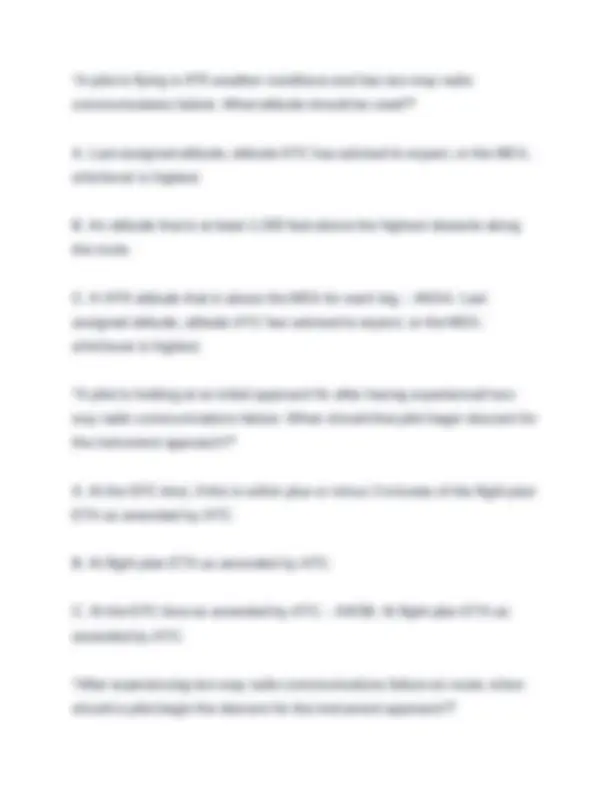
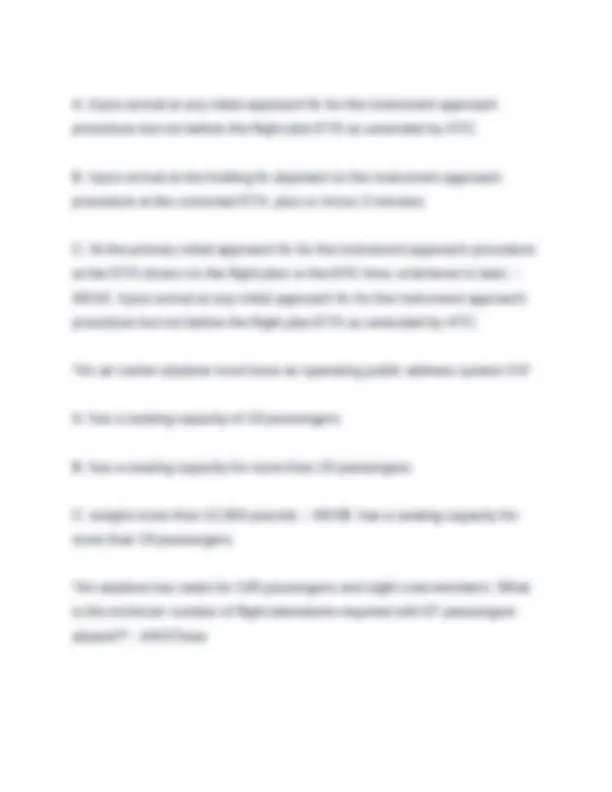
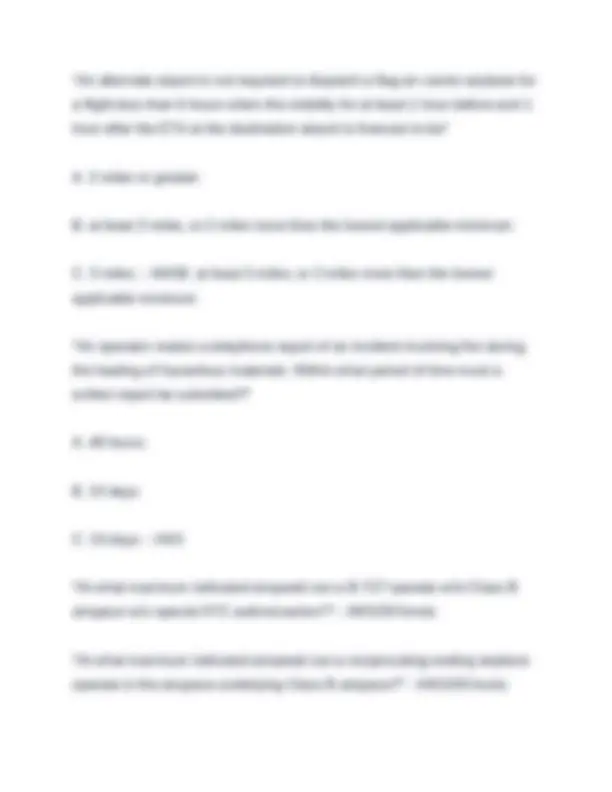
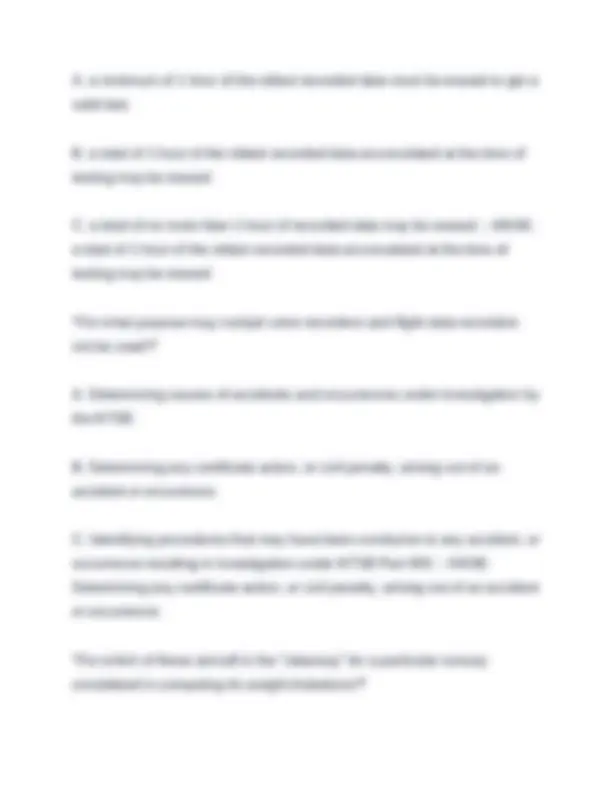
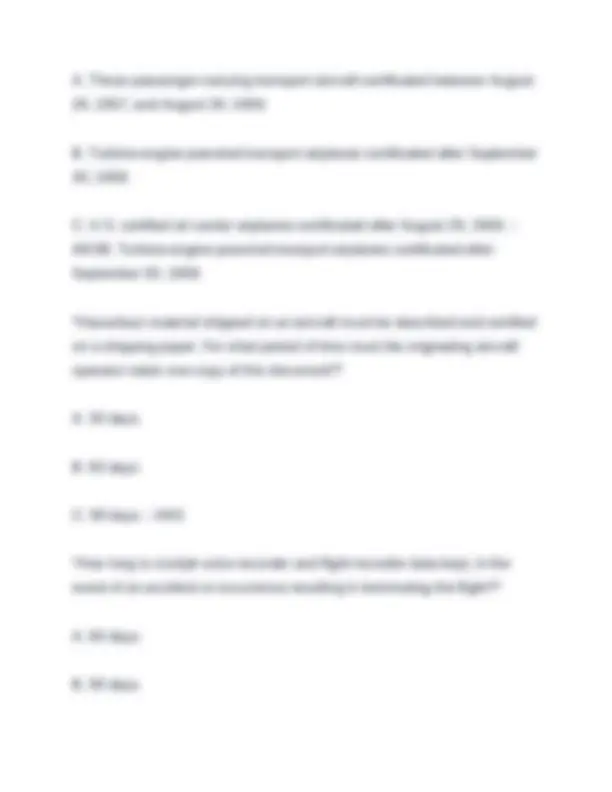
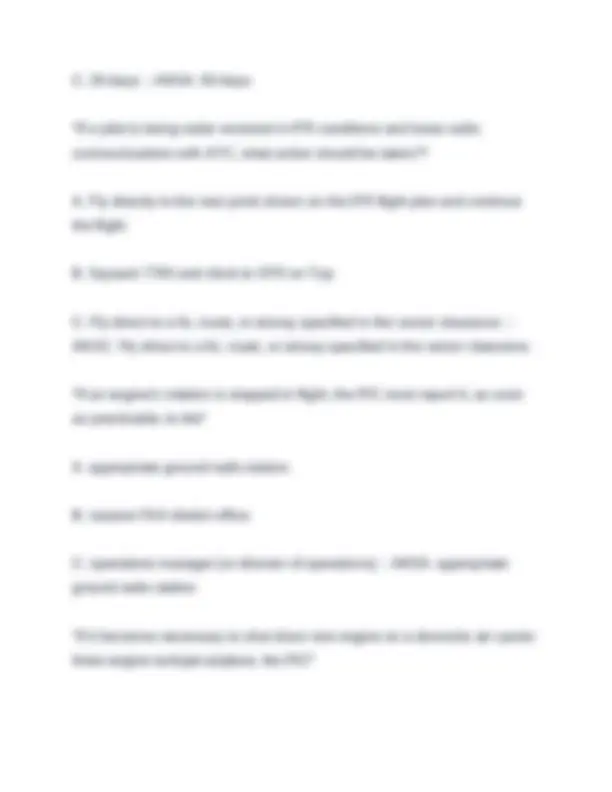
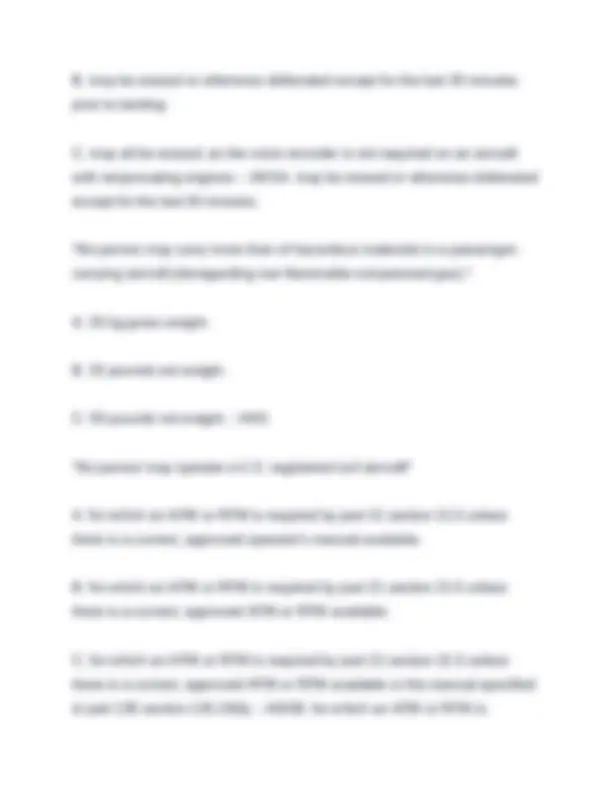
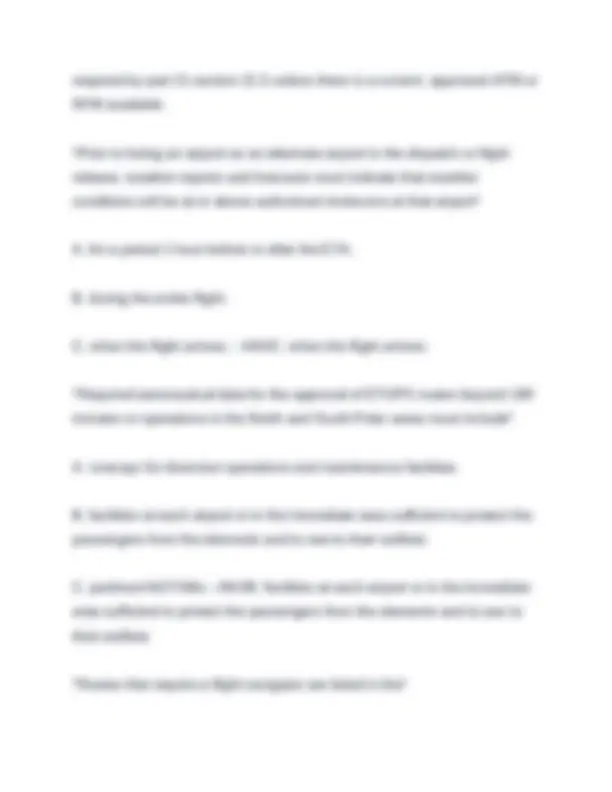
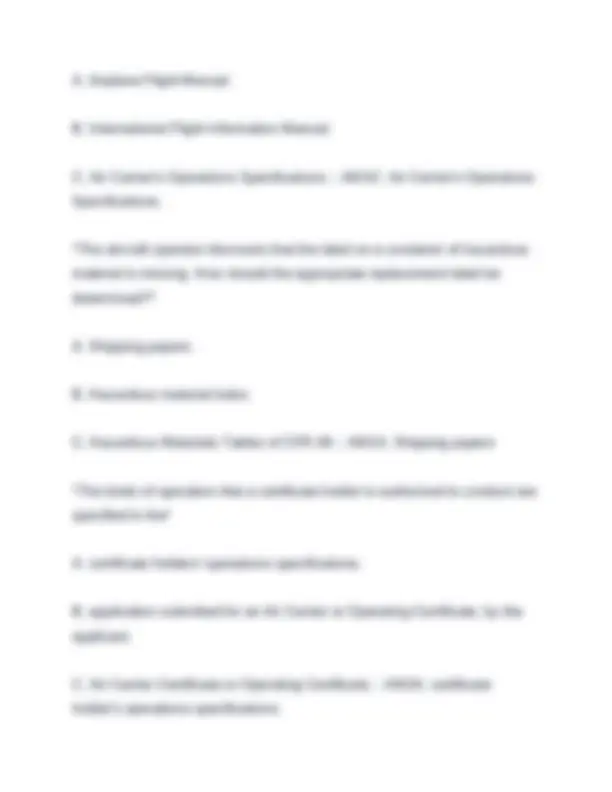
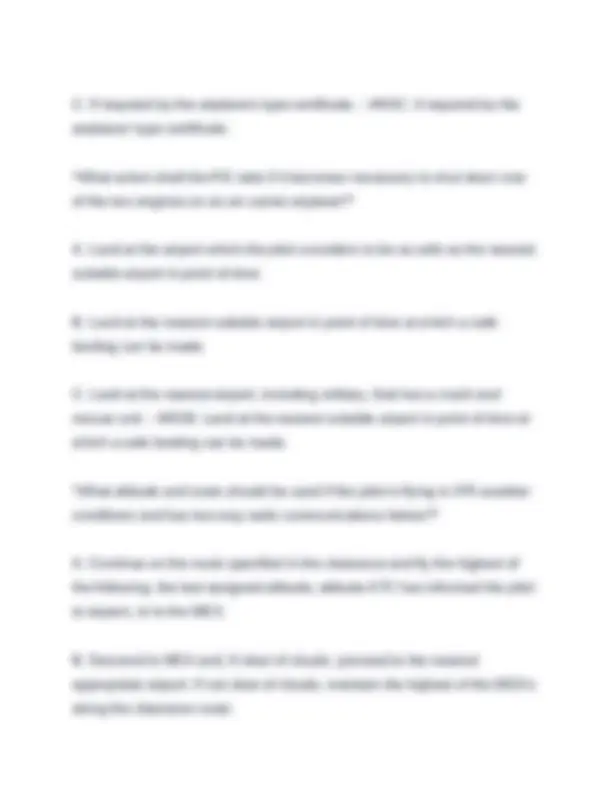
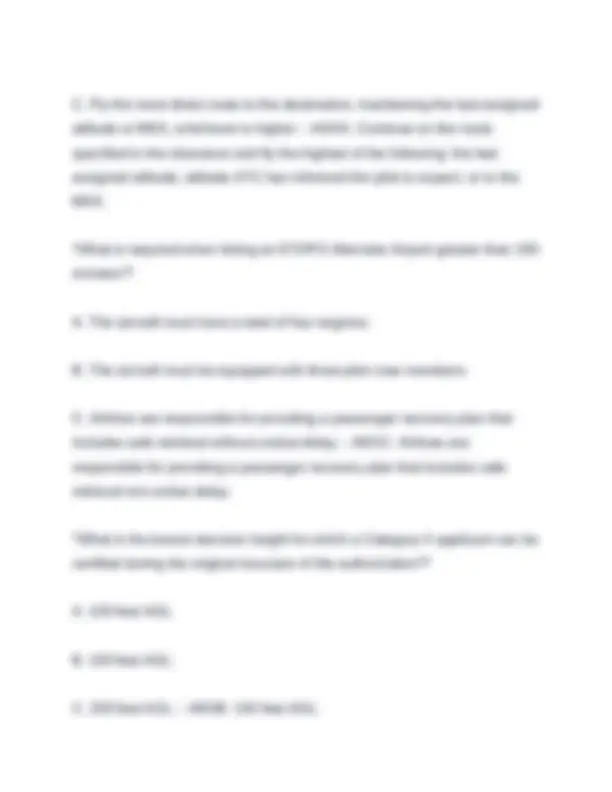
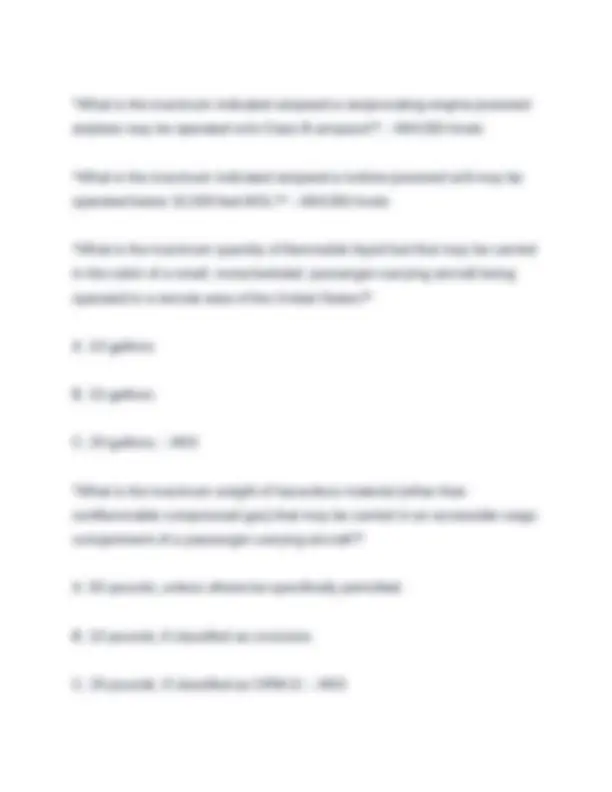
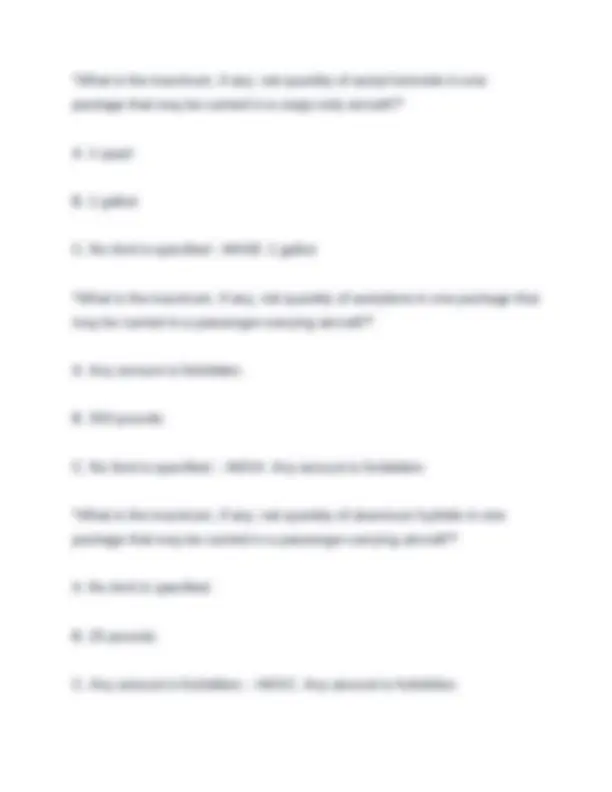
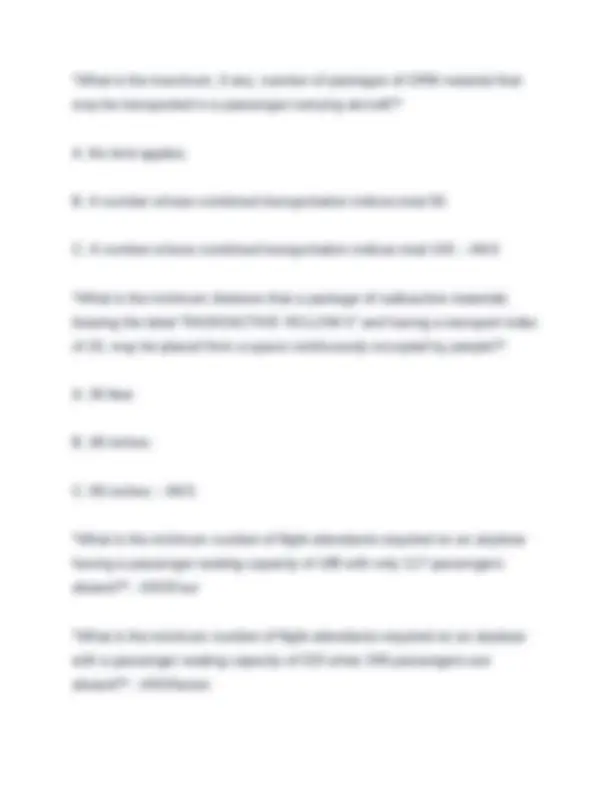
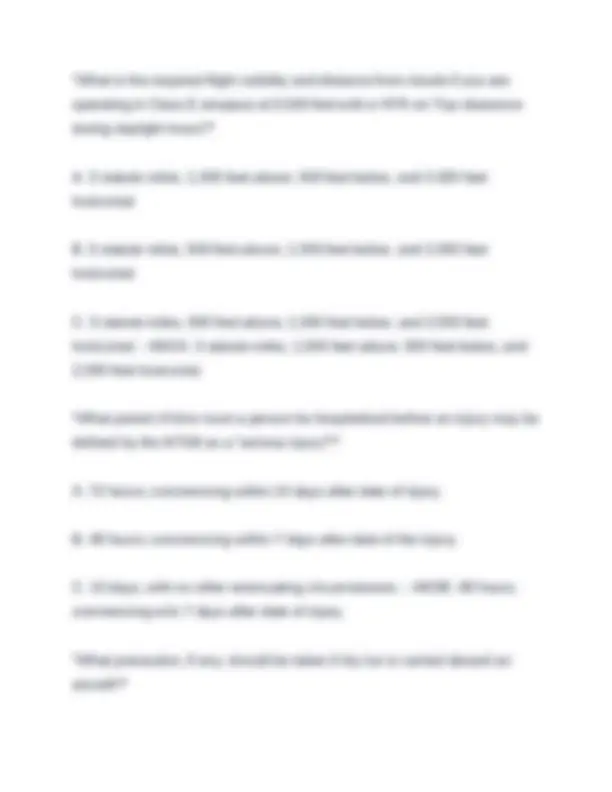
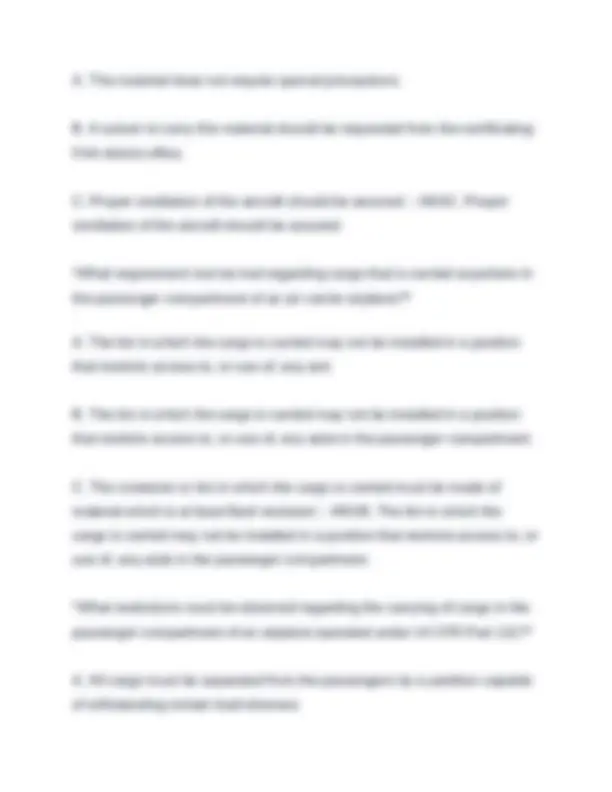
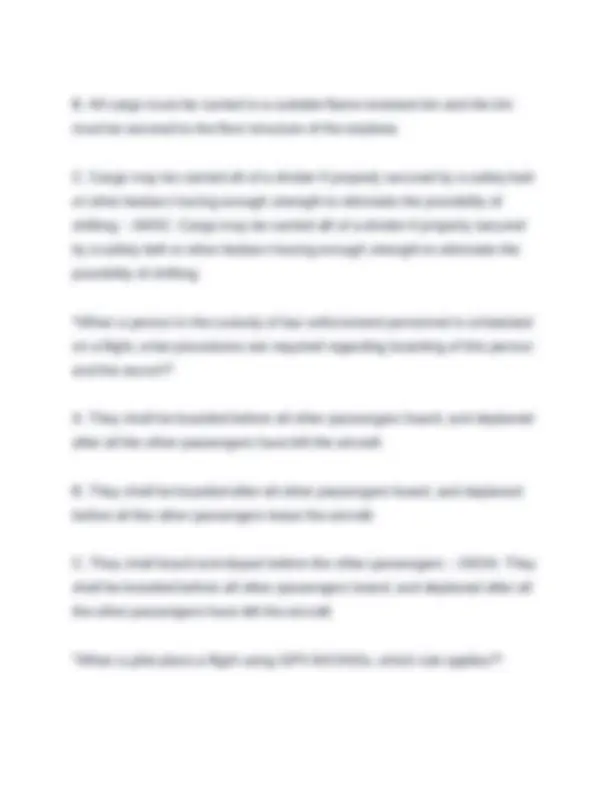
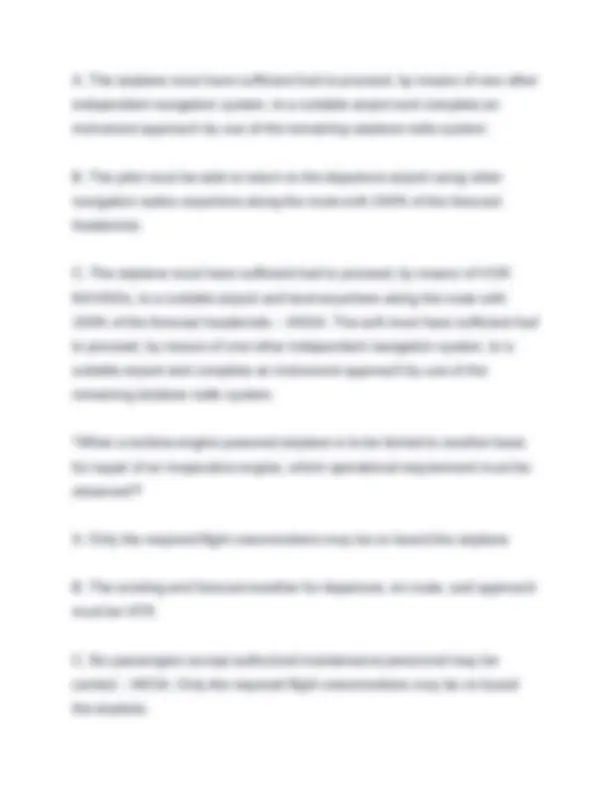
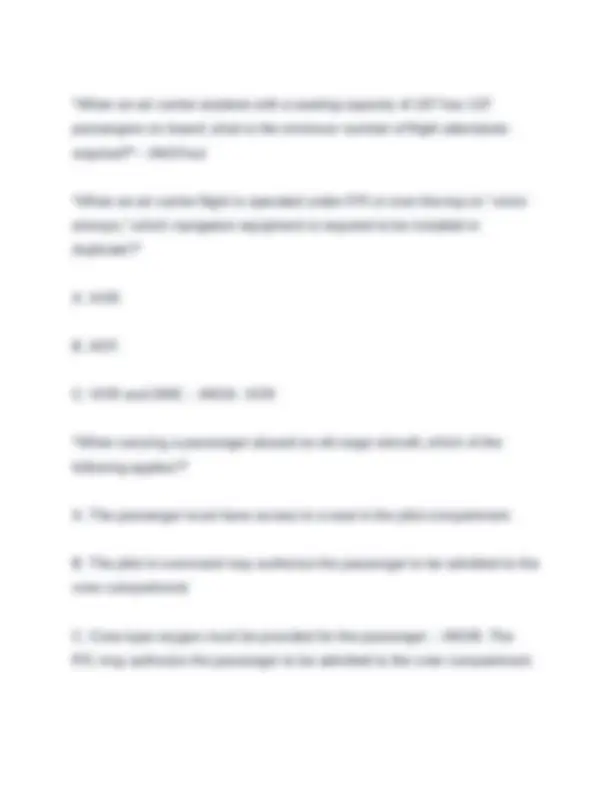
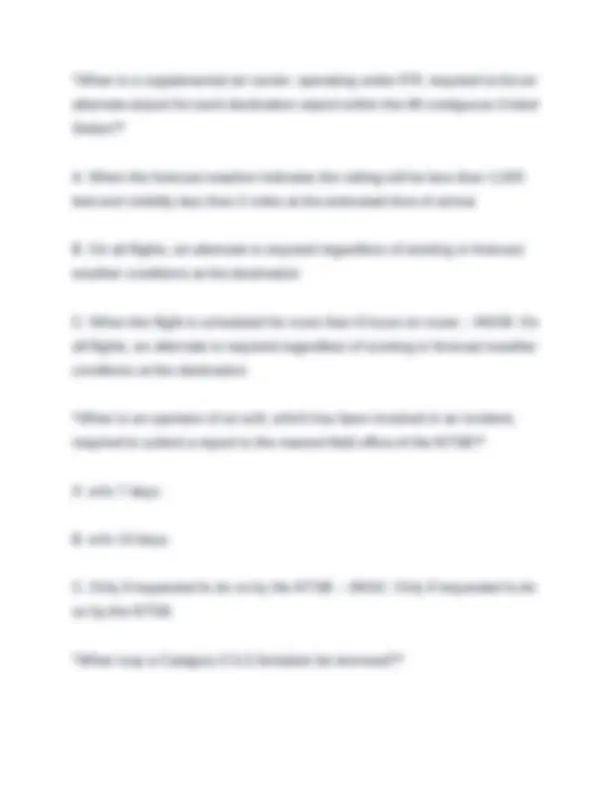
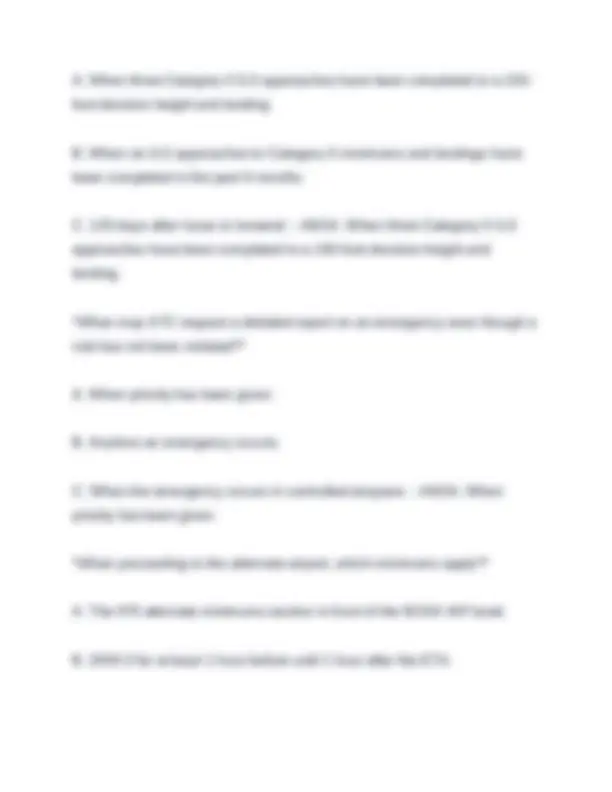
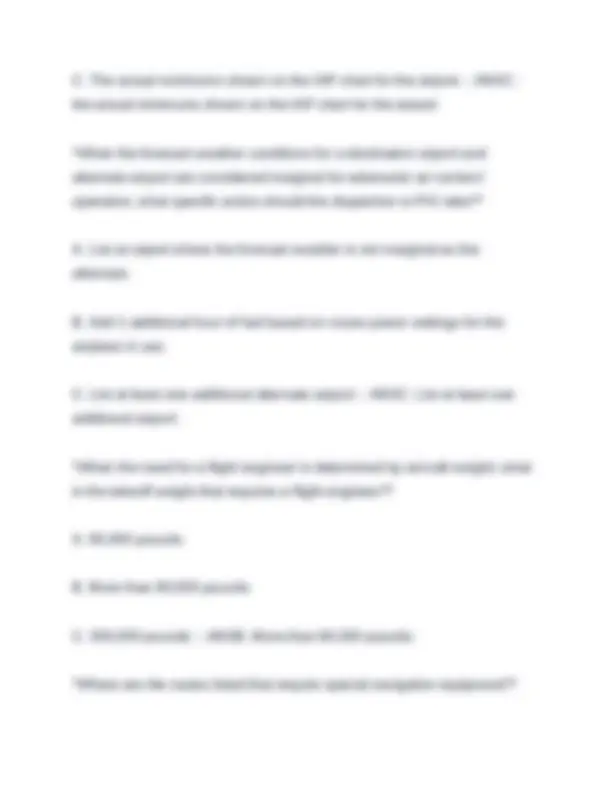
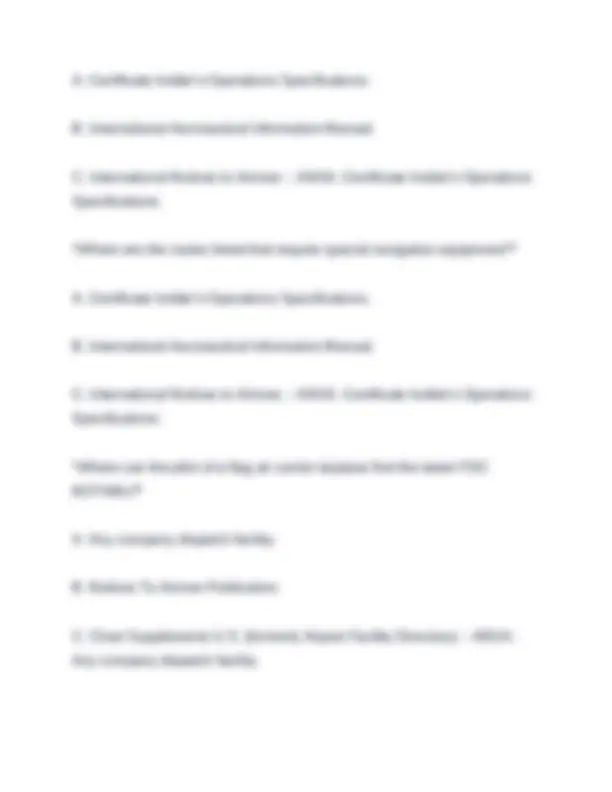
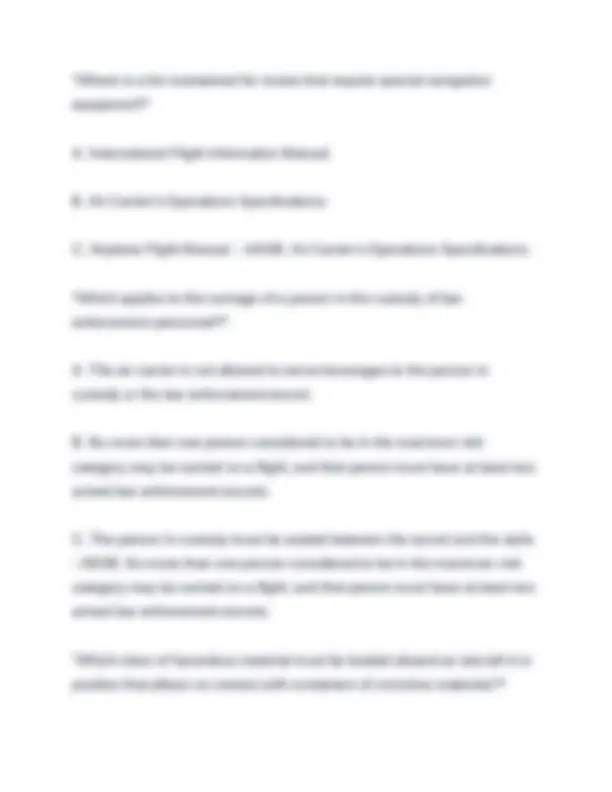
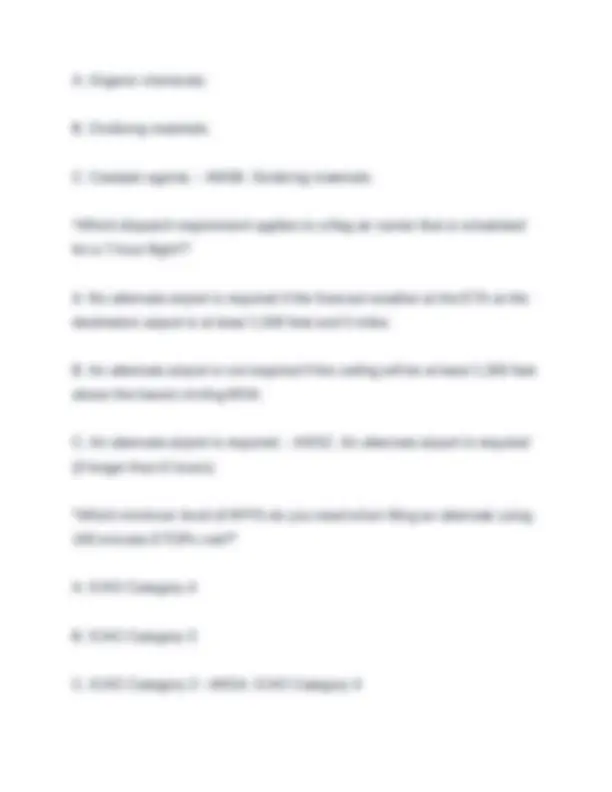
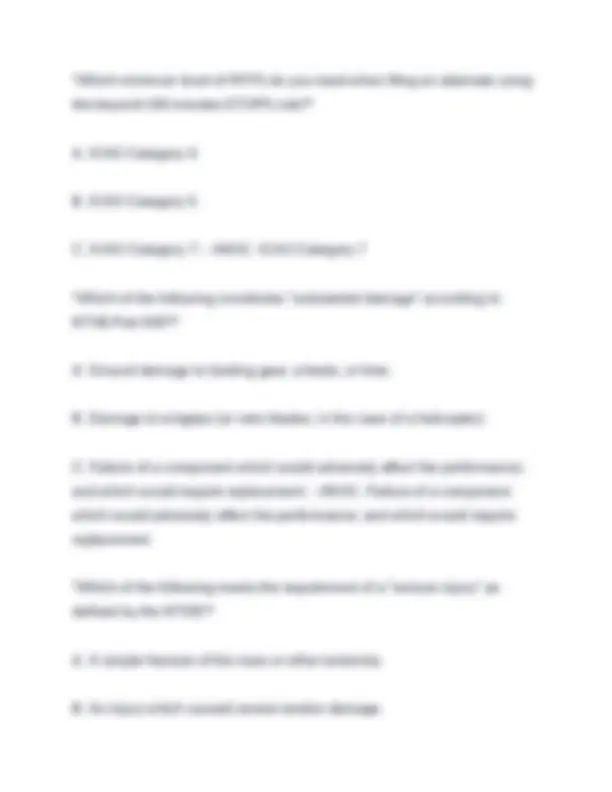
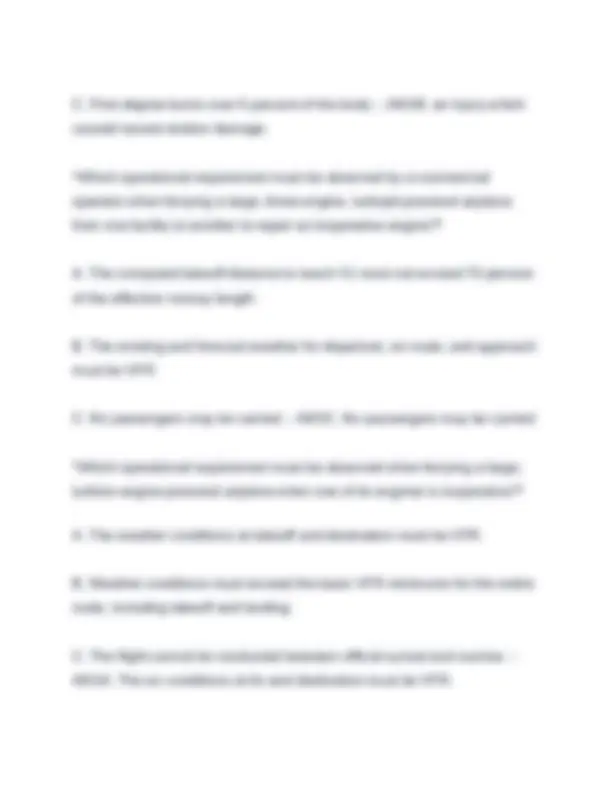
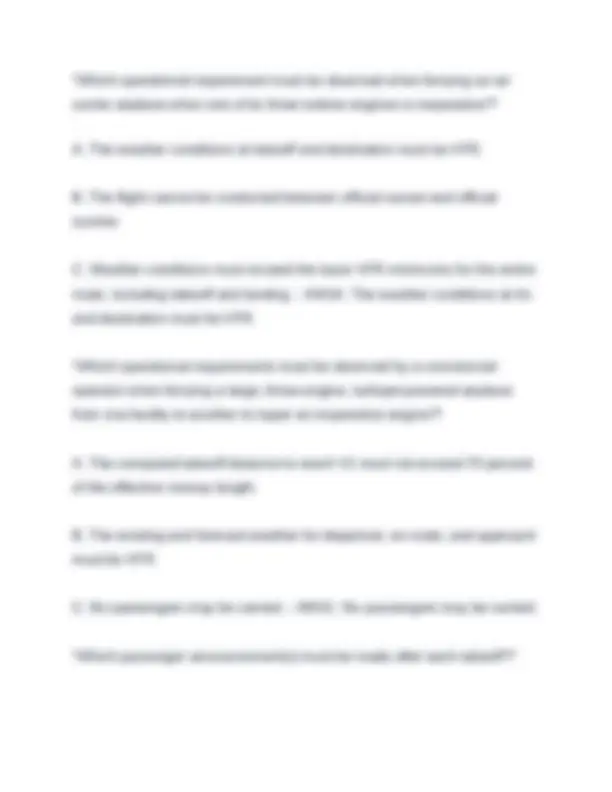
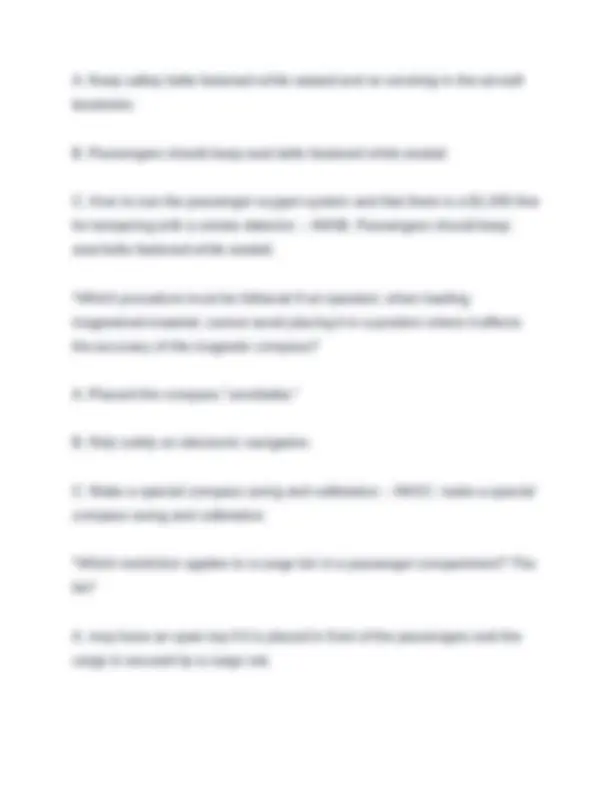
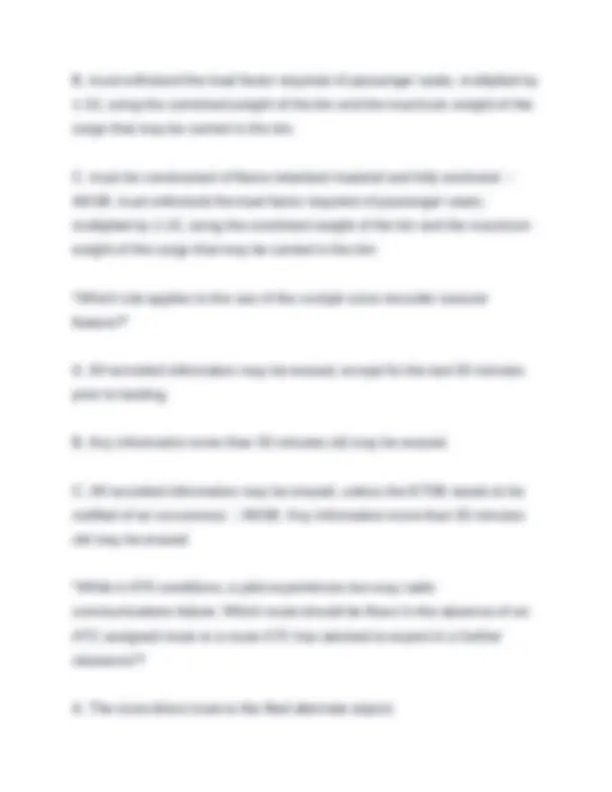

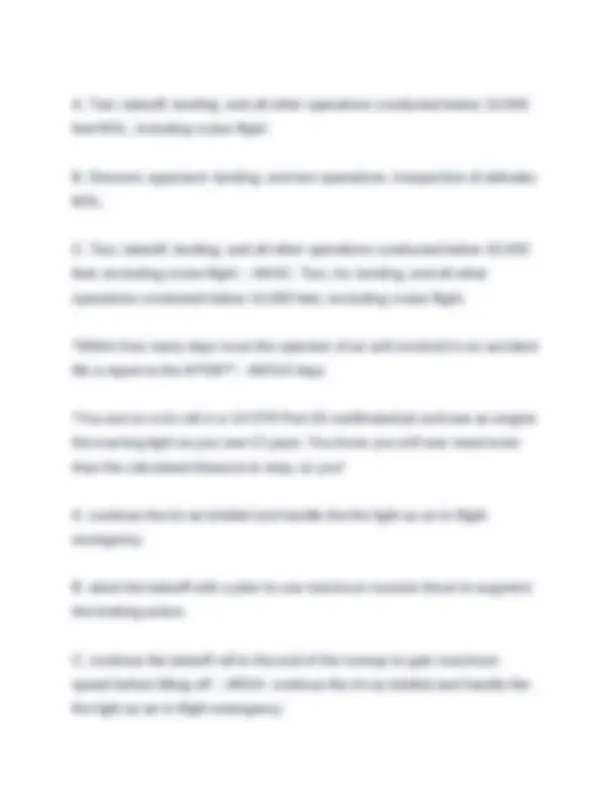


Study with the several resources on Docsity

Earn points by helping other students or get them with a premium plan


Prepare for your exams
Study with the several resources on Docsity

Earn points to download
Earn points by helping other students or get them with a premium plan
Community
Ask the community for help and clear up your study doubts
Discover the best universities in your country according to Docsity users
Free resources
Download our free guides on studying techniques, anxiety management strategies, and thesis advice from Docsity tutors
Gleim Study Units 1, 2, 3, 19, Appendix A Test Newest Edition 2025-2026. Questions & Correct Answers. Graded A
Typology: Exams
1 / 40

This page cannot be seen from the preview
Don't miss anything!

































C. Category II operations not less than 1200 RVR and a 100-foot DH. - ANSA. Category II operations not less than 1600 RVR and a 150-foot DH. A cockpit voice recorder must be operated A. from the start of the before starting engine checklist to completion of final checklist upon termination of flight. B. from the start of the before starting engine checklist to completion of checklist prior to engine shutdown. C. when starting to taxi for takeoff to the engine shutdown checklist after termination of the flight. - ANSA. from the start of the before starting engine checklist to completion of final checklist upon termination of flight. A flight navigator or a specialized means of navigation is required aboard an air carrier airplane operated outside the 48 contiguous United States and District of Columbia when A. operations are conducted IFR or VFR on Top. B. operations are conducted over water more than 50 miles from shore. C. the airplane's position cannot be reliably fixed for a period of more than 1 hour. - ANSC. the airplane's position cannot be reliably fixed for a period of more than 1 hour.
A. Upon arrival at any initial approach fix for the instrument approach procedure but not before the flight plan ETA as amended by ATC. B. Upon arrival at the holding fix depicted on the instrument approach procedure at the corrected ETA, plus or minus 3 minutes. C. At the primary initial approach fix for the instrument approach procedure at the ETA shown on the flight plan or the EFC time, whichever is later. - ANSA. Upon arrival at any initial approach fix for the instrument approach procedure but not before the flight plan ETA as amended by ATC. An air carrier airplane must have an operating public address system if it A. has a seating capacity of 19 passengers. B. has a seating capacity for more than 19 passengers. C. weighs more than 12,500 pounds. - ANSB. has a seating capacity for more than 19 passengers. An airplane has seats for 149 passengers and eight crewmembers. What is the minimum number of flight attendants required with 97 passengers aboard? - ANSThree
An alternate airport is not required to dispatch a flag air carrier airplane for a flight less than 6 hours when the visibility for at least 1 hour before and 1 hour after the ETA at the destination airport is forecast to be A. 2 miles or greater. B. at least 3 miles, or 2 miles more than the lowest applicable minimum. C. 3 miles. - ANSB. at least 3 miles, or 2 miles more than the lowest applicable minimum. An operator makes a telephone report of an incident involving fire during the loading of hazardous materials. Within what period of time must a written report be submitted? A. 48 hours. B. 10 days. C. 15 days. - ANS At what maximum indicated airspeed can a B-727 operate w/in Class B airspace w/o special ATC authorizaztion? - ANS250 knots At what maximum indicated airspeed can a reciprocating-ending airplane operate in the airspace underlying Class B airspace? - ANS200 knots
C. Upon request by ATC, submit a written report within 48 hours to the ATC manager. - ANSC. Upon request by ATC, submit a written report within 48 hours to the ATC manager. ETOPS entry points mean the first entry point on the route of flight of an ETOPS flight using one-engine-inoperative cruise speed that is more than A. 90 minutes from an adequate airport for airplanes having two engines. B. 60 mintues from an adequate airport for airplanes having two engines. C. 207 minutes from an adequate airport for airplanes having more than two engines. - ANSB. 60 minutes from an adequate airport for airplanes having two engines. Except when in cruise flight, below what altitidue are nonsafety-related cockpit activities by flight crewmembers prohibited? A. 10,000 feet B. 14,500 feet. C. FL 180. - ANSA. 10,000 feet For the purpose of testing the flight recorder system,
A. a minimum of 1 hour of the oldest recorded data must be erased to get a valid test. B. a total of 1 hour of the oldest recorded data accumulated at the time of testing may be erased. C. a total of no more than 1 hour of recorded data may be erased. - ANSB. a total of 1 hour of the oldest recorded data accumulated at the time of testing may be erased. For what purpose may cockpit voice recorders and flight data recorders not be used? A. Determining causes of accidents and occurrences under investigation by the NTSB. B. Determining any certificate action, or civil penalty, arising out of an accident or occurrence. C. Identifying procedures that may have been conducive to any accident, or occurrence resulting in investigation under NTSB Part 830. - ANSB. Determining any certificate action, or civil penalty, arising out of an accident or occurrence. For which of these aircraft is the "clearway" for a particular runway considered in computing t/o weight limitations?
C. 30 days. - ANSA. 60 days. If a pilot is being radar vectored in IFR conditions and loses radio communications with ATC, what action should be taken? A. Fly directly to the next point shown on the IFR flight plan and continue the flight. B. Squawk 7700 and climb to VFR on Top. C. Fly direct to a fix, route, or airway specified in the vector clearance. - ANSC. Fly direct to a fix, route, or airway specified in the vector clearance. If an engine's rotation is stopped in flight, the PIC must report it, as soon as practicable, to the A. appropriate ground radio station. B. nearest FAA district office. C. operations manager (or director of operations). - ANSA. appropriate ground radio station If it becomes necessary to shut down one engine on a domestic air carrier three-engine turbojet airplane, the PIC
A. must land at the nearest suitable airport, in point of time, at which a safe landing can be made. B. may continue to the planned destination if approved by the company aircraft dispatcher. C. may continue to the planned destination if this is considered as safe as landing at the nearest suitable airport. - ANSC. may continue to the planned destination if this is considered as safe as landing at the nearest suitable airport. If not excepted, what label, if any, must be placed on a package containing acetone? A. No label is required. B. POISON. C. FLAMMABLE LIQUID. - ANSC. FLAMMABLE LIQUID If not excepted, what label, if any, must be placed on a package containing allethrin? A. ORM-A. B. None.
B. may be erased or otherwise obliterated except for the last 30 minutes prior to landing. C. may all be erased, as the voice recorder is not required on an aircraft with reciprocating engines. - ANSA. may be erased or otherwise obliterated except for the last 30 minutes. No person may carry more than of hazardous materials in a passenger- carrying aircraft (disregarding non-flammable compressed gas). A. 25 kg gross weight. B. 25 pounds net weight. C. 55 pounds net weight. - ANS No person may operate a U.S. registered civil aircraft A. for which an AFM or RFM is required by part 21 section 21.5 unless there is a current, approved operator's manual available. B. for which an AFM or RFM is required by part 21 section 21.5 unless there is a current, approved AFM or RFM available. C. for which an AFM or RFM is required by part 21 section 21.5 unless there is a current, approved AFM or RFM available or the manual specified in part 135 section 135.19(b). - ANSB. for which an AFM or RFM is
required by part 21 section 21.5 unless there is a current, approved AFM or RFM available. Prior to listing an airport as an alternate airport in the dispatch or flight release, weather reports and forecasts must indicate that weather conditions will be at or above authorized minimums at that airport A. for a period 1 hour before or after the ETA. B. during the entire flight. C. when the flight arrives. - ANSC. when the flight arrives. Required aeronautical data for the approval of ETOPS routes beyond 180 minutes or operations in the North and South Polar areas must include A. runways for diversion operations and maintenance facilities. B. facilities at each airport or in the immediate area sufficient to protect the passengers from the elements and to see to their welfare. C. pertinent NOTAMs - ANSB. facilities at each airport or in the immediate area sufficient to protect the passengers from the elements and to see to their welfare. Routes that require a flight navigator are listed in the
The minimum wx conditions that must exist for an airport to be listed as an alternate in the dispatch release for a domestic air carrier flight are A. those listed in the NOAA IAP charts for the alternate airport, at the time the flight is expected to arrive. B. those specified in the certificate holder's Operations Specifications for that airport, when the flight arrives. C. those listed on the NOAA IAP charts for the alternate airport, from 1 hour before or after the ETA for that flight. - ANSB. those specified in the certificate holder's Operations Specifications for that airport, when the flight arrives. The persons jointly responsible for the initiation, continuation, diversion, and termination of a supplemental air carrier or commercial operator flight are the A. pilot in command and chief pilot. B. pilot in command and director of operations. C. pilot in command and the flight follower. - ANSB. PIC and director of operations
The pilot in command has emergency authority to exclude any and all persons from admittance to the flight deck A. except a FAA inspector doing enroute checks. B. in the interest of safety. C. except persons who have authorization from the certificate holder and the FAA or NTSB. - ANSB. in the interest of safety. The weather conditions that meet the minimum requirements for a flag air carrier to take off from an alternate airport that is not listed in the Operations Specifications are A. 800-2, 900-1-1/2, or 1000-1. B. 800-1/2, 900-1, or 1000-2. C. 800-1, 900-2, or 1000-3. - ANSA. 800-2, 900-1-1/2, or 1000-1. Under which condition is a flight engineer required as a flight crewmember in 14 CFR Part 121 operations? A. If the airplane is being flown on proving flights, with revenue cargo aboard. B. If the airplane is powered by more than two turbine engines.
C. Fly the most direct route to the destination, maintaining the last assigned altitude or MEA, whichever is higher. - ANSA. Continue on the route specified in the clearance and fly the highest of the following: the last assigned altitude, altitude ATC has informed the pilot to expect, or to the MEA. What is required when listing an ETOPS Alternate Airport greater than 180 minutes? A. The aircraft must have a total of four engines. B. The aircraft must be equipped with three pilot crew members. C. Airlines are responsible for providing a passenger recovery plan that includes safe retrieval without undue delay. - ANSC. Airlines are responsible for providing a passenger recovery plan that includes safe retrieval w/o undue delay. What is the lowest decision height for which a Category II applicant can be certified during the original issunace of the authorization? A. 100 feet AGL. B. 150 feet AGL. C. 200 feet AGL. - ANSB. 150 feet AGL.
What is the maximum indicated airspeed a reciprocating-engine-powered airplane may be operated w/in Class B airspace? - ANS250 knots What is the maximum indicated airspeed a turbine-powered acft may be operated below 10,000 feet MSL? - ANS250 knots What is the maximum quantity of flammable liquid fuel that may be carried in the cabin of a small, nonscheduled, passenger-carrying aircraft being operated in a remote area of the United States? A. 10 gallons. B. 15 gallons. C. 20 gallons. - ANS What is the maximum weight of hazardous material (other than nonflammable compressed gas) that may be carried in an accessible cargo compartment of a passenger-carrying aircraft? A. 50 pounds, unless otherwise specifically permitted. B. 10 pounds, if classified as corrosive. C. 25 pounds, if classified as ORM-D. - ANS